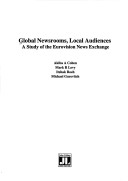Acamedia Research Monograph S.
1 primary work
Book 12
Global Newsrooms, Local Audiences
by Akiba A. Cohen, etc., Mark Levy, and Itzhak Roeh
Published 1 January 1996
Every day, the images that become the substance of television news are fed across time zones, continents and cultures via satellite by a small number of supranational wholesalers of television news stories. This monograph presents a detailed examination of one key player in the rapidly changing world of international television news - the Eurovision News Exchange (EVN), which is the journalistic arm of the better-known European Broadcasting Union (EBU). In three decades, the EVN has grown to become a leading video "wire service", the main source of television footage for dozens of countries worldwide. Unlike CNN, which broadcasts finished news stories to the public, the EVN provides the "raw" news footage to the world's television broadcasters, and the national TV news services in turn create the news which is seen on national newscasts. Based on surveys, field observations and work with focus groups carried out in a dozen different nations by an international team of scholars, these findings represent an up-to-date look at the EVN, and offers details about international television news.
The book shows: how the journalists of the EVN decide what's news; how news from the EVN is "domesticated" by local broadcasters to meet the "requirements" of local audiences; and how television viewers "decode" and learn from foreign news which comes to them, at least in part, through the agency of the EVN.
The book shows: how the journalists of the EVN decide what's news; how news from the EVN is "domesticated" by local broadcasters to meet the "requirements" of local audiences; and how television viewers "decode" and learn from foreign news which comes to them, at least in part, through the agency of the EVN.
